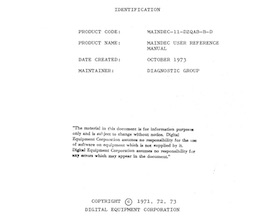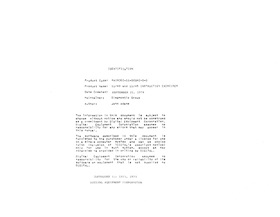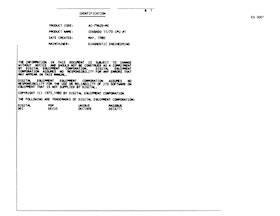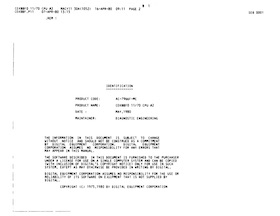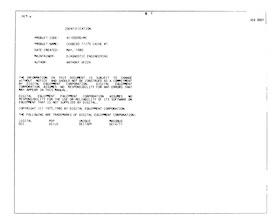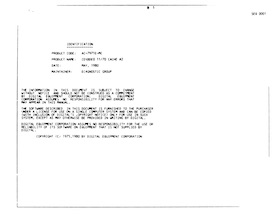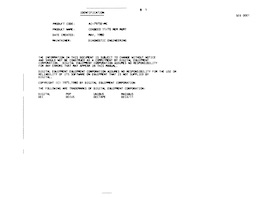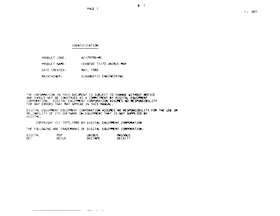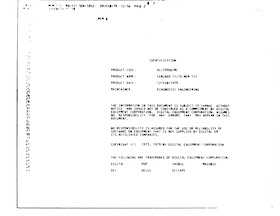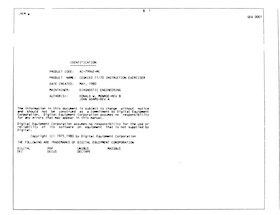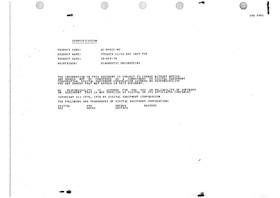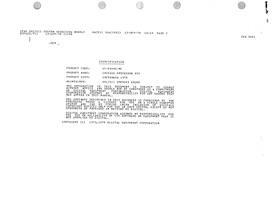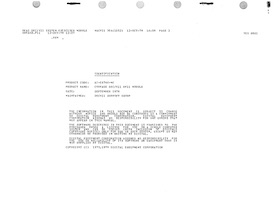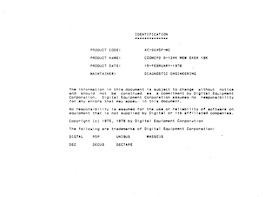PCjs Machines
Home of the original IBM PC emulator for browsers.

DEC PDP-11 Paper Tape Diagnostics
Thanks to the iamvirtual.ca website, we have been able to archive the PDP-11 diagnostics shown below. The tapes have been added to the Default PC11 Configuration, so that you can easily load them into any machine with a PC11, such as this PDP-11/20 with Front Panel and Debugger.
As noted for other DEC PDP-11 Tape Images, these “Absolute Format” tapes can be read directly into RAM using the machine’s Read button instead of Load, allowing you to bypass the usual multi-step process of loading the Bootstrap Loader in order to load the Absolute Loader in order to load the desired tape.
Additional (non-paper tape) diagnostics are available on the XXDP+ Diagnostics disk.
Running Paper Tape Diagnostics
Tests 1-12
Instructions for running “TEST 1 - BRANCH” through “TEST 12 - JUMP” come from the MAINDEC-11-DZQAB MAINDEC USER REFERENCE MANUAL (Oct 1973), page 19:
MAINDEC-11-D0AA to D0LA (NEW NUMBER - DZKAA to DZKAL)
T1 to T12
ABSTRACT
This is a group of 12 tests that incrementally test and isolate simple
malfunctions of the PDP-11. The tests should be run in the indicated
numerical sequence. The sequence is:
1. Branch
2. Conditional Branch
3. Unary
4. Unary and Binarys
5. Rotate/Shift
6. Compare (Equality)
7. Compare (non equality)
8. Move
9. Bit Set, Clear and Test
10. Add
11. Subtract
12. Jump
REQUIREMENTS
PDP-11
STORAGE - Use all of 4K [words] except 17500 - 17776 (Reserved for boot and
absolute loader)
LOADING - Absolute Loader
EXECUTION TIME - 246 min, depending on test - Bell will ring
STARTING PROCEDURE - Start and Restart at 200
PRINTOUTS - No
SWITCH REGISTER OPTIONS - No
The code for “TEST 1 - BRANCH” is not terribly exciting. Most of its 8Kb length is filled with these three repeated instructions:
000210: 060100 ADD R1,R0
000212: 000401 BR 000216
000214: 000000 HALT
until it reaches this point:
014202: 005267 000022 INC 014230
014206: 001006 BNE 014224
014210: 012737 000207 177566 MOV #207,@#177566
014216: 105737 177564 TSTB @#177564
014222: 100375 BPL 014216
014224: 000167 163750 JMP 000200
014230: 000000 HALT
where it increments a zero-initialized word. When the word wraps around to zero again, it will output a BELL character (with bit 7 set; I’m not sure why) to the machine’s display terminal, and then run the test again. If a BR instruction fails to branch for some strange reason, then in theory, the machine will fall through to a HALT instruction, and the test will halt.
Test 13
MAINDEC-11-D0MA (NEW NUMBER - DZKAM)
T13
ABSTRACT
This is a test of the JSR, RTS and RTI instructions. It is also the
first time the Register 6 has been "PUSHED and POPPED".
REQUIREMENTS
PDP-11
STORAGE - 0 - 5000
LOADING - Absolute Loader
EXECUTION TIME - 2 min - Bell will ring
STARTING PROCEDURE - Start and Restart at 200
PRINTOUTS - No
SWITCH REGISTER OPTIONS - No
Test 14
Note that, as the instructions indicate, this test will fail on a PDP-11/45 or newer machine, because it expects the MUL instruction to trap.
This test is also noteworthy because it uncovered a bug involving instructions like this:
MOV R0,(R0)+
Imagine that R0 contains 1000. PDPjs would write the value 1000 to address 1000 after auto-incrementing R0 to 1002.
Unfortunately, that’s wrong – for the PDP-11/20 anyway. Apparently, unlike later (micro-coded) models, the PDP-11/20 performs both source and destination address calculations before reading and writing the source and destination values. So, in the above example, the value 1002 must be written to address 1000.
MAINDEC-11-D0NA (NEW NUMBER - DAKAA)
T14 TRAPS
ABSTRACT
This is a test of all operation and instruction that cause traps.
Also tested are trap overflow conditions, oddities of register 6,
interrupts and the reset instructions.
REQUIREMENTS
PDP-11/20, 11/05, 11/10
STORAGE - 0 - 17500
LOADING - Absolute Loader
EXECUTION TIME - Function or core size - Bell will ring
STARTING PROCEDURE
Start and Restart at 200 for a 4K System
202 for an 8K System
204 for a 12K System
206 for a 16K System
210 for a 20K System
212 for a 24K System
214 for a 28K System
PRINTOUTS - No
SWITCH REGISTER OPTIONS - No
This program should not be used to test 11/40 and 11/45's.
Test 15
Before loading and running this test on the PDP-11/20 with Front Panel and Debugger, it’s recommended that you also toggle SW-15, as described below, so that the test will HALT on any failure.
Also, this test, like Test 14, fails on a PDP-11/45 or newer machine. In this case, it’s because DEC changed the behavior of the RTI instruction on newer models.
MAINDEC-11-D0OA (NEW NUMBER - DZQKA)
T15 Instruction Exerciser
ABSTRACT
This program is designed to be a comprehensive check of all 11 family
processor instructions. The program executed each instruction in all
address modes and includes tests for traps and the teletype interrupt
sequence. The program relocates the test code throughout memory 0-28K.
REQUIREMENTS
PDP-11 family central processor
Optional - KL11-L (line clock)
STORAGE - Program uses all the first 4K of memory (excluding that area
of memory reserved for the loaders.)
LOADING - Absolute Loader
EXECUTION TIME - For 4K - 1 min, for 28K - 5 min.
STARTING PROCEDURE - 200
PRINTOUTS - Yes
SWITCH REGISTER OPTIONS - Yes
SW15 = .... HALT ON ERROR
SW14 = .... LOOP SUBTEST
SW13 = .... INHIBIT ERROR PRINTOUT
SW12 = .... INHIBIT TRACE TRAPPING
SW11 = .... INHIBIT SUBTEST ITERATION
SW10 = .... RING BELL ON ERROR
SW 8 = .... LOAD PDP-11/45 MICRO BREAK REGISTER
SW 7-0 = .... WHEN SET LOADS THE MICRO BREAK REGISTER WITH THE VALUE
SET INTO SW7-0 AT THE BEGINNING OF EACH SUBTEST
NOTE
WHEN ALL SWITCHES ARE DOWN NO TYPEOUTS
WILL OCCUR AT THE END OF A PASS (errors
will be typed). SETTING SW7 WILL CAUSE
END OF PASS MESSAGE TO BE TYPED.
Newer Paper Tape Software (mid-1970s)
Thanks to the efforts of person(s) unknown, additional paper tape images have been uploaded to bitsavers.org. It’s not super organized, so for now, I’m just going to pick out selected tapes and archive them here.
From bitsavers.org, Tray 02:
- Tape 04: MAINDEC-11-DEQKC-B1-PB 06/12/78; 11/70 cpu instruction exerciser; (c)1975,76 [1980 Listing]
MD-11 11/70 CPU EXERCISER
When started in a PDP-11/70 with no disk drives installed, this diagnostic displays the following startup information (“EXERCISOR” is DEC’s typo, not mine):
MAINDEC-11-DEQKC-B...PDP 11/70 CPU EXERCISOR
OPT.CP=145406
OPERATIONAL SWITCH SETTINGS
SWITCH USE
15 HALT ON ERROR
14 LOOP ON TEST
13 INHIBIT ERROR TYPEOUTS
12 INHIBIT UBE
11 INHIBIT ITTERATIONS
10 BELL ON ERROR
9 LOOP ON ERROR
8 INHIBIT RELOCATION VIA I/O DEVICE
7 INHIBIT TYPEOUT OF THIS TEXT AND SYS SIZE
6 INHIBIT RELOCATION
5 INHIBIT ROUND ROBIN RELOCATION
4 INHIBIT RANDOM DISK ADDRESS
3 INHIBIT MBT
2 THESE THREE SWITCHES
1 ARE ENCODED TO SELECT RELOCATION
0 ON THE FOLLOWING DEVICES:
0...RP11/RP03
1...RK11/RK05
2...NOT USED
3...NOT USED
4...RH70/RP04
5...RH70/RS04 OR RS03
6...NOT USED
7...NOT USED
THE FOLLOWING DEVICES AND DRIVES WILL BE USED FOR RELOCATION:
DEVICE DRIVES
TYPE A CHARACTER TO CONTINUE
The first time I tried this test, there were a number of failures. Here’s one example:
000:00:00
ERRORPC PHYSC PC PSW MAINT TEST NO SUB-PASS CNT
022024 00022024 000340 000000 000041 000000 000000
I disassembled the code responsible for that failure:
021632: 052737 000340 177776 BIS #340,@#177776
021640: 010746 MOV PC,-(SP)
021642: 062716 000152 ADD #152,@SP
021646: 011637 000004 MOV @SP,@#4
021652: 012737 000340 000006 MOV #340,@#6
021660: 013727 000014 001472 MOV @#14,#1472
021666: 062716 000100 ADD #100,@SP
021672: 012637 000014 MOV (SP)+,@#14
021676: 012737 000340 000016 MOV #340,@#16
021704: 012703 000376 MOV #376,R3
021710: 010313 MOV R3,@R3
021712: 010306 MOV R3,SP
021714: 032767 140000 000234 BIT #140000,022156
021722: 001015 BNE 021756
021724: 005716 TST @SP
021726: 021666 177776 CMP @SP,177776(SP)
021732: 012656 MOV (SP)+,@-(SP)
021734: 057636 000000 BIS @000000(SP),@(SP)+
021740: 054676 000000 BIS -(SP),@000000(SP)
021744: 005006 CLR SP
021746: 013766 020000 020000 MOV @#20000,20000(SP)
021754: 000425 BR 022030
021756: 156737 000175 177777 BISB 022157,@#177777
021764: 012706 000376 MOV #376,SP
021770: 016646 177776 MOV 177776(SP),-(SP)
021774: 051616 BIS @SP,@SP
021776: 061666 177776 ADD @SP,177776(SP)
022002: 105037 177777 CLRB @#177777
022006: 012706 000700 MOV #700,SP
022012: 000451 BR 022136
022014: 012600 MOV (SP)+,R0
022016: 012602 MOV (SP)+,R2
022020: 012706 000700 MOV #700,SP
022024: 104000 EMT 000
I wasn’t able to locate a source code listing for this particular (1978) version of the 11/70 CPU Instruction Exerciser, but I did find another useful document, MAINDEC-11-DCQKC 11/40 and 11/45 INSTRUCTION EXERCISER (Sep 1974), where I discovered a matching test sequence on page 86.
Here’s an excerpt:
; THE BELOW INSTRUCTIONS SHOULD NOT CAUSE AN OVERFLOW TRAP
TST (SP) ; BECAUSE TST IS A NON MODIFYING INST
CMP (SP),-2(SP) ; SO IS COMPARE
MOV (SP)+,@-(SP) ; BECAUSE OF ADDRESS MODE 5
BIS @(SP),@(SP)+ ; BECAUSE OF ADDRESS MODE 3
BIS -(SP),@(SP) ; BECAUSE OF ADDRESS MODE 7
CLR SP
MOV @#20000,20000(SP)
BR 3$ ; BRANCH OVER NON KERNEL MODE TESTS
This test uncovered a number of stack overflow-related issues that PDPjs needed to resolve, including the fact that none of the “deferred” addressing modes (3, 5, or 7) apparently trigger a stack overflow; eg:
R0=000000 R1=154112 R2=155754 R3=000376 R4=160316 R5=153412
SP=000376 PC=021734 PS=000340 IR=000000 SL=000377 T0 N0 Z0 V0 C0
021734: 057636 000000 BIS @000000(SP),@(SP)+
whereas addressing mode 6 does; eg:
R0=001437 R1=154112 R2=000040 R3=000376 R4=160316 R5=153412
SP=000376 PC=022074 PS=000340 IR=000000 SL=000377 T0 N0 Z0 V0 C0
022074: 050666 177776 BIS SP,177776(SP)
I have to assume that the idiosyncrasies of stack overflow checking changed over time, because Test 14, which predates the 11/45 and 11/70, expects this instruction:
TST -(SP)
to trap when SP is 150. That contradicts this newer test (ie, that TST should not cause an overflow trap “BECAUSE TST IS A NON MODIFYING INST”). For this and other reasons, PDPjs now installs different checkStackLimit() handlers based on the CPU model.
UPDATE: Another (1980) version of the source code for this diagnostic has been located and archived with the rest of our DEC PDP-11 Diagnostic Publications:
You’ll find the above excerpt on page 114, at address 024624.
Here’s the next test that PDPjs failed. Again, I found the same sequence of instructions in the 11/40 and 11/45 version of the diagnostic, at PC 023360 rather than 023450, so I’ve annotated the code below with DEC’s comments:
023450: 012704 000001 MOV #1,R4 ;SET R4
023454: 006767 000060 SXT 023540 ;PRESET DATA=0
023460: 074467 000054 XOR R4,023540
023464: 100423 BMI 023534
023466: 006304 ASL R4 ;SHIFT R4
023470: 102373 BVC 023460 ;UNTIL V SETS (R4=100000)
023472: 100020 BPL 023534 ;BRANCH IF 'N' IS CLEAR
023474: 074467 000040 XOR R4,023540 ;XOR6A=177777
023500: 100015 BPL 023534
023502: 074767 000032 XOR PC,023540 ;XOR PC WITH XOR6A (177777)
023506: 010767 000030 MOV PC,023542 ;FORM PC AS USED IN XOR ABOVE
023512: 162767 000004 000022 SUB #4,023542
023520: 005167 000016 COM 023542
023524: 026767 000012 000006 CMP 023542,023540 ;XOR6A SHOULD = COMPLEMENT OF PC
023532: 001401 BEQ 023536
023534: 104000 EMT 000 ;ERROR: XOR TESTS ABOVE FAILED [They use HLT instead of EMT here]
In my case, the failure was caused by the XOR instruction. When I fixed the PDP-11/20 issue uncovered by Test 14, I had neglected to update XOR, which has some unique operand decoding logic.

















